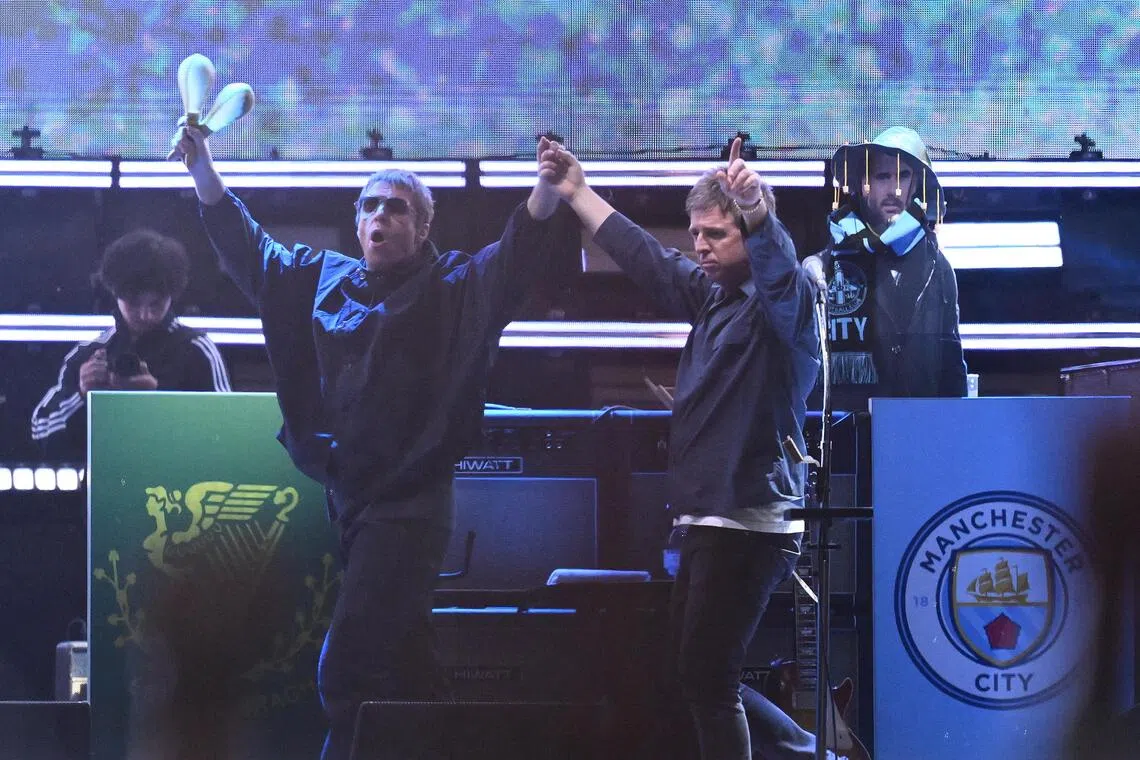Oasis' reunion in Japan strikes chord with new generation of fans
Sign up now: Get ST's newsletters delivered to your inbox

Liam Gallagher (left) and Noel Gallagher arrive on stage during the first show of their Australian tour at Marvel Stadium, in Melbourne.
PHOTO: EPA
Follow topic:
TOKYO - When Oasis took to the stage on Oct 25 for their first concert in Japan in 16 years, the roar that filled Tokyo Dome was not only from fans who had followed the English rock band since the 1990s.
Among the 50,000-strong crowd were also thousands of younger listeners who had discovered the Britpop legends after their 2009 split and not through record stores or radio, but music streaming services.
The sold-out gig marked a symbolic moment for both generations.
It showed how, in the subscription era, music from decades past can circulate as freely as the latest hits, bridging the gap between those who once bought Oasis albums on CD and those who stream them on digital platforms such as Spotify.
“I discovered Oasis through Alexandros, a Japanese band I was a fan of,” a 23-year-old apparel store clerk from Chiba Prefecture said. “I thought this might be my first and last chance to see them.”
As Oasis members Noel and Liam Gallagher appeared on the stage with their hands held aloft – a moment of unity from the Mancunian brothers after years of feuding – the Dome erupted.
The swagger was still there: Liam, hands clasped behind his back, stared down the crowd as he growled through classics like Some Might Say (1995) and Wonderwall (1995), with fans of all ages joining in.
“(Back in the day) they looked so effortlessly cool...Their sibling rivalry was thrilling too,” said Ms Miho Hayashi, a company employee from Toyama who has been an Oasis fan since high school.
The 48-year-old attended the concert with her teenage daughter, who grew up hearing the band’s songs “like lullabies”.
The cross-generational enthusiasm extended far beyond the concert venue.
In the days leading up to the show, Miyashita Park in Shibuya was transformed into an Oasis-themed hub, with digital billboards looping music videos and a pop-up shop selling T-shirts and posters as well as Japan-exclusive merchandise such as teacups.
“The reunion is like a festival,” said one woman in her 30s, who spent over 20,000 yen (S$170) on merch including a Gallagher-themed acrylic stand.
“Fans want something physical to connect with,” explained Sony Music Entertainment’s Kumiko Muto. “They collect items as part of their fandom activities. In that sense, Oasis fans today aren’t that different from fans of pop idols.”
The data backs up this renewed interest. According to American research firm Luminate, the week Oasis’ reunion was announced in August saw around 120 million streams of their music worldwide – more than triple the previous week’s total.
When the reunion tour began in July, weekly plays again exceeded 100 million.
That spike reflects a broader transformation in global music listening habits. In the streaming era, so-called “catalogue” music – older albums released more than 18 months ago – now accounts for the majority of listening.
Luminate reports that in the American market in 2024, new releases made up just 26.7 per cent of streams, while catalogue albums comprised 73.3 per cent. In rock music, the dominance of older material is even greater.
For younger fans, the algorithm has replaced the record shop clerk. Songs from the 1990s surface alongside current chart-toppers, blurring the sense of musical generations.
As the final notes of Stand By Me (1997) rang out at Tokyo Dome, Liam Gallagher sang the line, “Sing me something new”. But the concert itself suggested that what is “new” has taken on a different meaning. KYODO NEWS

